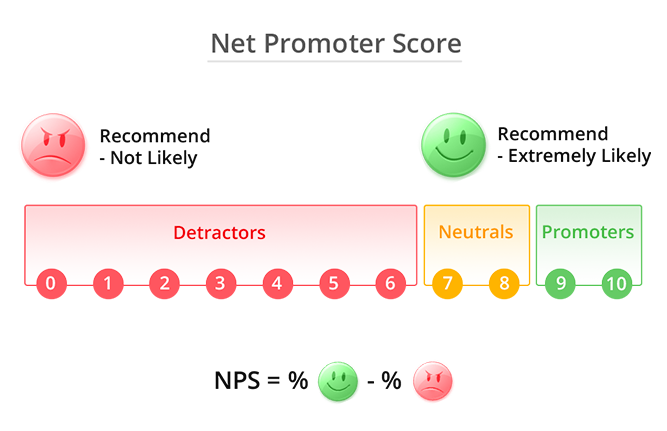A successful business is inevitably the one that puts its customers at the front and center of everything – from product design to product experience. Understanding and addressing your customer’s needs and expectations is a sure-shot way to drive your business growth. But how do you do that? How do you read your customers’ mindset?
Net Promoter Score (NPS) is one such metric that can help you understand if your customers are happy/satisfied with your product/service.
What is NPS?
Net Promoter Score (NPS) is a globally recognized and widely accepted metric that helps you measure your customer’s loyalty and satisfaction. It quantifies how satisfied your customers are with your product/service and how likely they are to recommend your product/service to their friends and colleagues.
How is NPS calculated?
To calculate NPS, pose the following survey question to your customers:
“On a scale from 0 to 10, how likely are you to recommend this brand/product/service to a friend or colleague? (with ten being most likely to recommend and zero being not at all likely to recommend).”
Use the customer’s responses to group them into the following categories:
- Promoters – Those who provide ratings of 9-10.
- Passives – Those who provide ratings of 7-8.
- Detractors – Those who provide ratings ranging between 0-6.
Proceed and calculate your NPS using the formula:
NPS = % Promoters – % Detractors

Simply put, the Net Promoter Score (NPS) is the percentage of customers who are Promoters (those who provided ratings of 9 or 10) minus the percentage who are Detractors (those who provided ratings of 0 to 6).
Therefore, the NPS score can take values between -100 to 100, with:
- -100 implying that all customers are Detractors, and
- 100 implying that all customers are Promoters.
How does the NPS score measure customer loyalty and impact business growth?
The three different categories used to group the customers (Promoters, Passives, and Detractors) have been observed to have typical attitudes and behaviors with economic implications.
For example:
- Promoters (ratings – 9 or 10) – are your most passionately loyal customers and brand enthusiasts. They are also most likely to repurchase your products and drive organic growth for your business via word-of-mouth referrals.
- Passives (ratings – 7 or 8) – tend to be passively satisfied with your business. That is, they are currently satisfied with your product but are likely to jump ship if enticed by your competitor’s offerings. Their repurchase and referral rates tend to be much lower than those of your promoters.
- Detractors (ratings – 0 to 6) – are your unsatisfied customers. Not only are these customers least likely to repurchase from you, but they can cause significant damage to your brand reputation and discourage potential customers away from your business.
The greater the percentage of your Promoters, the greater is your NPS score. Similarly lower the percentage of your Detractors, the lower your NPS score.
Therefore, a high NPS score is an indicator of the businesses’ healthy relationship with its customers. Such a businesses’ customers are most likely to sing its praises and drive organic growth for the business.
How can you use the NPS score to drive business growth?
You can compile and track the NPS score for your company as a whole, as well as individually for a product line, a store, or your customer support team. Use the changes in the NPS score over time to understand how your business decisions impact your customers’ satisfaction levels.
But, NPS can only tell you what your customers think of you, but it doesn’t answer why. We, therefore, recommend that you supplement the NPS survey question with an additional open-ended question to seek additional comments/ remarks from your customers. These customer comments can provide valuable insights into your customers’ pain points and expectations from your brand. It allows you the opportunity to truly use your customers’ feedback to drive future business decisions and create a customer-centric organization.
Also, we recommend that you seek an NPS response immediately after your clients’ interaction with your business, for example, after they make a purchase or after they interact with your customer care. It considerably increases the chances of your customers submitting their feedback, and the feedback received is more likely to reflect their actual experience.
NPS is an extremely simple to use tool; it considerably saves your as well as your customers’ time and gives an accurate insight into what your customers think of you. Incorporating it into your marketing strategy makes quite a lot of sense, doesn’t it?
Suggested Reading: Adding an NPS survey to Landing Pages and Emails, NPS survey analytics in MainBrainer.
